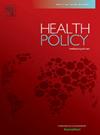全科医生护理的接触时间:描述模式和文献的范围审查
IF 3.4
3区 医学
Q1 HEALTH CARE SCIENCES & SERVICES
引用次数: 0
摘要
背景:全科医生接触时间(GP)指的是医生在预约期间与患者接触的时间。经合组织国家之间的接触时间存在显著差异,这引发了有关这些差异的影响因素和潜在后果的问题。目的研究全科医生会诊时间长短的影响因素及后果。方法:我们描述性地调查了经合组织国家全科医生平均预约时间的差异。然后,我们对包括七个主题集群的150项研究在内的文献进行了范围审查。结果我们确定了各国在接触时间上的相当大的差异,并发现了磋商长度和每年磋商次数之间的替代效应的证据。报销计划和访问时长之间也存在关联。该审查揭示了一些决定因素的一致证据,如患者特征和医生经验,但接触时间对共同决策和健康结果的影响的证据不一。文献以相关研究为主。结论描述性比较表明,较短的就诊时间被较频繁的就诊时间所取代,而按服务收费的就诊时间比按人头收费的就诊时间更长。在今后的卫生政策讨论中,至关重要的是要澄清哪种服务提供形式是社会所需要的,在经济上是可持续的。本文章由计算机程序翻译,如有差异,请以英文原文为准。
Contact time in GP Care: Descriptive patterns and a scoping review of the literature
Background
Contact time in general practice (GP) refers to the duration a physician spends with a patient during an appointment. There are significant differences in contact times across OECD countries, raising questions about the influencing factors and potential consequences of these variations.
Objective
To study the determinants and consequences of the length of consultations in GP care.
Method
We descriptively investigate differences in average appointment durations in GP care across OECD countries. We then conduct a scoping review of the literature encompassing 150 studies in seven topical clusters.
Results
We identify considerable differences in contact times across countries and find evidence for substitution effects between the length of consultations and the number of consultations per year. There is also an association between reimbursement schemes and visit lengths. The review reveals consistent evidence for a few determinants, such as patient characteristics and physician experience, but mixed evidence on the effects of contact time on shared decision-making and health outcomes. The literature is dominated by correlational studies.
Conclusion
Descriptive comparisons show shorter contact times are substituted with more frequent visits, and fee-for-service payment systems result in longer contact times compared to capitation systems. For future health policy discussions, it is crucial to clarify which service delivery form is socially desired and economically sustainable.
求助全文
通过发布文献求助,成功后即可免费获取论文全文。
去求助
来源期刊

Health Policy
医学-卫生保健
CiteScore
6.40
自引率
6.10%
发文量
157
审稿时长
3-8 weeks
期刊介绍:
Health Policy is intended to be a vehicle for the exploration and discussion of health policy and health system issues and is aimed in particular at enhancing communication between health policy and system researchers, legislators, decision-makers and professionals concerned with developing, implementing, and analysing health policy, health systems and health care reforms, primarily in high-income countries outside the U.S.A.
 求助内容:
求助内容: 应助结果提醒方式:
应助结果提醒方式:


